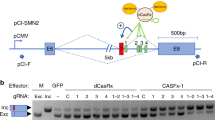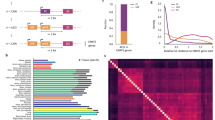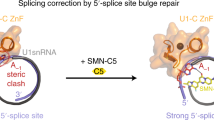Abstract
Many diseases affect pre-mRNA splicing, and alternative splicing is a major source of proteome diversity and an important mechanism for modulating gene expression. The ability to regulate a specific splicing event is therefore desirable; for example, to understand splicing-associated pathologies. We have developed methods based on modified U7 snRNAs, which allow us to induce efficient skipping or inclusion of selected exons. Here, we have adapted these U7 tools to a regulatable system that relies on a doxycycline-sensitive version of the Krüppel-associated box (KRAB)/KAP1 transcriptional silencing. Co-transduction of target cells with two lentiviral vectors, one carrying the KRAB protein and the other the regulatable U7 cassette, allows a tight regulation of the modified U7 snRNA. No leakage is observed in the repressed state, whereas full induction can be obtained with doxycycline in ng ml−1 concentrations. Only a few days are necessary for a full switch, and the induction/repression can be repeated over several cycles without noticeable loss of control. Importantly, the U7 expression correlates with splicing correction, as shown for the skipping of an aberrant β-globin exon created by a thalassaemic mutation and the promotion of exon 7 inclusion in the human SMN2 gene, an important therapeutic target for spinal muscular atrophy.
This is a preview of subscription content, access via your institution
Access options
Subscribe to this journal
Receive 12 print issues and online access
$259.00 per year
only $21.58 per issue
Buy this article
- Purchase on Springer Link
- Instant access to full article PDF
Prices may be subject to local taxes which are calculated during checkout





Similar content being viewed by others
References
Modrek B, Lee C . A genomic view of alternative splicing. Nat Genet 2002; 30: 13–19.
Matlin AJ, Clark F, Smith CWJ . Understanding alternative splicing: towards a cellular code. Nat Rev Mol Cell Biol 2005; 6: 386–398.
Cartegni L, Chew SL, Krainer AR . Listening to silence and understanding nonsense: exonic mutations that affect splicing. Nat Rev Genet 2002; 3: 285–298.
Sazani P, Kole R . Therapeutic potential of antisense oligonucleotides as modulators of alternative splicing. J Clin Invest 2003; 112: 481–486.
Aartsma-Rus A, van Ommen GJ . Antisense-mediated exon skipping: a versatile tool with therapeutic and research applications. RNA 2007; 13: 1609–1624.
Asparuhova M, Kole R, Schümperli D . Antisense derivatives of U7 and other small nuclear RNAs as tools to modify pre-mRNA splicing patterns. Gene Ther Regul 2004; 2: 321–349.
Gorman L, Suter D, Emerick V, Schümperli D, Kole R . Stable alteration of pre-mRNA splicing patterns by modified U7 small nuclear RNAs. Proc Natl Acad Sci USA 1998; 95: 4929–4934.
Suter D, Tomasini R, Reber U, Gorman L, Kole R, Schümperli D . Double-target antisense U7 snRNAs promote efficient skipping of an aberrant exon in three human beta-thalassemic mutations. Hum Mol Genet 1999; 8: 2415–2423.
Brun C, Suter D, Pauli C, Dunant P, Lochmüller H, Burgunder JM et al. U7 snRNAs induce correction of mutated dystrophin pre-mRNA by exon skipping. Cell Mol Life Sci 2003; 60: 557–566.
De Angelis FG, Sthandier O, Berarducci B, Toso S, Galluzzi G, Ricci E et al. Chimeric snRNA molecules carrying antisense sequences against the splice junctions of exon 51 of the dystrophin pre-mRNA induce exon skipping and restoration of a dystrophin synthesis in Delta 48–50 DMD cells. Proc Natl Acad Sci USA 2002; 99: 9456–9461.
Goyenvalle A, Vulin A, Fougerousse F, Leturcq F, Kaplan JC, Garcia L et al. Rescue of dystrophic muscle through U7 snRNA-mediated exon skipping. Science 2004; 306: 1796–1799.
Liu S, Asparuhova M, Brondani V, Ziekau I, Klimkait T, Schümperli D . Inhibition of HIV-1 multiplication by antisense U7 snRNAs and siRNAs targeting cyclophilin A. Nucleic Acids Res 2004; 32: 3752–3759.
Asparuhova MB, Marti G, Liu S, Serhan F, Trono D, Schümperli D . Inhibition of HIV-1 multiplication by a modified U7 snRNA inducing Tat and Rev exon skipping. J Gene Med 2007; 9: 323–334.
Marquis J, Meyer K, Angehrn L, Kämpfer SS, Rothen-Rutishauser B, Schümperli D . Spinal muscular atrophy: SMN2 pre-mRNA splicing corrected by a U7 snRNA derivative carrying a splicing enhancer sequence. Mol Ther 2007; 15: 1479–1486.
Madocsai C, Lim SR, Geib T, Lam BJ, Hertel KJ . Correction of SMN2 pre-mRNA splicing by antisense U7 small nuclear RNAs. Mol Ther 2005; 12: 1013–1022.
Hernandez N . Small nuclear RNA genes: a model system to study fundamental mechanisms of transcription. J Biol Chem 2001; 276: 26733–26736.
Hernandez N, Weiner AM . Formation of the 3′ end of U1 snRNA requires compatible snRNA promoter elements. Cell 1986; 47: 249–258.
Neuman de Vegvar HE, Lund E, Dahlberg JE . 3′ end formation of U1 snRNA precursors is coupled to transcription from snRNA promoters. Cell 1986; 47: 259–266.
Hernandez N, Lucito R . Elements required for transcription initiation of the human U2 snRNA gene coincide with elements required for snRNA 3′ end formation. EMBO J 1988; 7: 3125–3134.
Wiznerowicz M, Trono D . Conditional suppression of cellular genes: lentivirus vector-mediated drug-inducible RNA interference. J Virol 2003; 77: 8957–8961.
Zhu Z, Zheng T, Lee CG, Homer RJ, Elias JA . Tetracycline-controlled transcriptional regulation systems: advances and application in transgenic animal modeling. Semin Cell Dev Biol 2002; 13: 121–128.
Szulc J, Wiznerowicz M, Sauvain MO, Trono D, Aebischer P . A versatile tool for conditional gene expression and knockdown. Nat Methods 2006; 3: 109–116.
Zhang ML, Lorson CL, Androphy EJ, Zhou J . An in vivo reporter system for measuring increased inclusion of exon 7 in SMN2 mRNA: potential therapy of SMA. Gene Therapy 2001; 8: 1532–1538.
Sierakowska H, Sambade MJ, Agrawal S, Kole R . Repair of thalassemic human beta-globin mRNA in mammalian cells by antisense oligonucleotides. Proc Natl Acad Sci USA 1996; 93: 12840–12844.
Schwerk C, Schulze-Osthoff K . Regulation of apoptosis by alternative pre-mRNA splicing. Mol Cell 2005; 19: 1–13.
Pajares MJ, Ezponda T, Catena Rl, Calvo A, Pio R, Montuenga LM . Alternative splicing: an emerging topic in molecular and clinical oncology. Lancet Oncol 2007; 8: 349–357.
Li Q, Lee JA, Black DL . Neuronal regulation of alternative pre-mRNA splicing. Nat Rev Neurosci 2007; 8: 819–831.
Monani UR, Sendtner M, Coovert DD, Parsons DW, Andreassi C, Le TT et al. The human centromeric survival motor neuron gene (SMN2) rescues embryonic lethality in Smn(−/−) mice and results in a mouse with spinal muscular atrophy. Hum Mol Genet 2000; 9: 333–339.
Le TT, Pham LT, Butchbach ME, Zhang HL, Monani UR, Coovert DD et al. SMNDelta7, the major product of the centromeric survival motor neuron (SMN2) gene, extends survival in mice with spinal muscular atrophy and associates with full-length SMN. Hum Mol Genet 2005; 14: 845–857.
Wiznerowicz M, Jakobsson J, Szulc J, Liao S, Quazzola A, Beermann F et al. The Kruppel-associated box repressor domain can trigger de Novo Promoter methylation during mouse early embryogenesis. J Biol Chem 2007; 282: 34535–34541.
Acknowledgements
We thank Karin Schranz for technical help, Didier Trono and Isabelle Barde from EPFL Lausanne for the gift of lentiviral vectors and for performing copy number analyses by real-time PCR, respectively. This study was supported by AFM (Association Française contre les Myopathies), EURASNET (European Network of Excellence on Alternative Splicing) and the Kanton Bern.
Author information
Authors and Affiliations
Corresponding author
Additional information
Supplementary Information accompanies the paper on Gene Therapy website (http://www.nature.com/gt)
Supplementary information
Rights and permissions
About this article
Cite this article
Marquis, J., Kämpfer, S., Angehrn, L. et al. Doxycycline-controlled splicing modulation by regulated antisense U7 snRNA expression cassettes. Gene Ther 16, 70–77 (2009). https://doi.org/10.1038/gt.2008.138
Received:
Revised:
Accepted:
Published:
Issue Date:
DOI: https://doi.org/10.1038/gt.2008.138
Keywords
This article is cited by
-
Overexpression of miR-210 and its significance in ischemic tissue damage
Scientific Reports (2017)
-
Somatic Therapy of a Mouse SMA Model with a U7 snRNA Gene Correcting SMN2 Splicing
Molecular Therapy (2016)
-
Progress in therapeutic antisense applications for neuromuscular disorders
European Journal of Human Genetics (2010)



